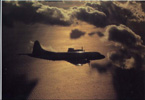ChezDaJez
Posts: 3436
Joined: 11/12/2004
From: Chehalis, WA
Status: offline

|
quote:
ORIGINAL: RevRick
quote:
ORIGINAL: ChezDaJez
That looks like a standard Hickory. Note the lack of a MAD boom or bomb racks.
MAD has always been a very short range sensor that is primarily used today as an attack sensor to confirm the target's position just prior to weapon release. I would highly doubt that WWII MAD systems had an effective detection range greater than about 200 feet. That is why the aircraft has to fly so low. Even today, the range is all that great and MAD runs are still conducted at low altitude.
In shallow water, MAD is often useless due to the number of false alarms caused from shipwrecks or rock/mineral deposits. Plus the aircraft must fly straight and level or remain in a constant rate turn to keep the MAD head stabilized. Any maneuvering can introduce a false reading.
One other thing to consider is that any time a major component of the aircraft is changed, such as an engine, the MAD equipment must be recalibrated. In the P-3 community, we called these recalibration flight "MAD comps" for MAD compensation. This was not the type of flight you want to find yourself on if you were prone to motion sickness. Lots of wing rocking, diving, climbing, yawing... they were fun!!! I used to like to stand in the galley of the P-3 while they did the compensation checks. You could actually get a feeling of weightlessness for a few seconds.
Chez
Wimp. We used to do that sitting moored to the quay in port, if the breeze was right. Try riding a tin can in the North Atlantic chasing the bubbleheads around whilst you guys rode around upstairs giving us false leads. 
False leads? I think you have us mixed up with them S-3 Viking boys. They couldn't find a sub even if it torped their carrier!   
But seriously, the only difference between P-3 aircrews and tincan sailors is that we only had to wait about 12 hours to have a beer, not 12 weeks!!! 
Chez
_____________________________
Ret Navy AWCS (1972-1998)
VP-5, Jacksonville, Fl 1973-78
ASW Ops Center, Rota, Spain 1978-81
VP-40, Mt View, Ca 1981-87
Patrol Wing 10, Mt View, CA 1987-90
ASW Ops Center, Adak, Ak 1990-92
NRD Seattle 1992-96
VP-46, Whidbey Isl, Wa 1996-98
|
 Printable Version
Printable Version















 New Messages
New Messages No New Messages
No New Messages Hot Topic w/ New Messages
Hot Topic w/ New Messages Hot Topic w/o New Messages
Hot Topic w/o New Messages Locked w/ New Messages
Locked w/ New Messages Locked w/o New Messages
Locked w/o New Messages Post New Thread
Post New Thread